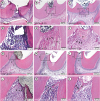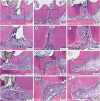1. Kakehashi S, Stanley HR, Fitzgerald RJ. The effects of surgical exposures of dental pulps in germ-free and conventional laboratory rats. Oral Surg Oral Med Oral Pathol. 1965; 20:340–349.

2. ISO. ISO 7405: 2008 Dentistry - Evaluation of biocompatibility of medical devices used in dentistry. Part 6: test procedures specific to dental materials. 2nd ed. New York (NY): International Organization for Standardization;2008. p. 19–27.
3. Dammaschke T. Rat molar teeth as a study model for direct pulp capping research in dentistry. Lab Anim. 2010; 44:1–6.

4. Decup F, Six N, Palmier B, Buch D, Lasfargues JJ, Salih E, Goldberg M. Bone sialoprotein-induced reparative dentinogenesis in the pulp of rat's molar. Clin Oral Investig. 2000; 4:110–119.

5. Six N, Lasfargues JJ, Goldberg M. Differential repair responses in the coronal and radicular areas of the exposed rat molar pulp induced by recombinant human bone morphogenetic protein 7 (osteogenic protein 1). Arch Oral Biol. 2002; 47:177–187.

6. Louwakul P, Lertchirakarn V. Response of inflamed pulps of rat molars after capping with pulp-capping material containing fluocinolone acetonide. J Endod. 2015; 41:508–512.

7. Dammaschke T, Stratmann U, Fischer RJ, Sagheri D, Schäfer E. A histologic investigation of direct pulp capping in rodents with dentin adhesives and calcium hydroxide. Quintessence Int. 2010; 41:e62–e71.
8. Hayashi K, Handa K, Koike T, Saito T. The possibility of genistein as a new direct pulp capping agent. Dent Mater J. 2013; 32:976–985.

9. Liu S, Wang S, Dong Y. Evaluation of a bioceramic as a pulp capping agent in vitro and in vivo
. J Endod. 2015; 41:652–657.
10. Long Y, Liu S, Zhu L, Liang Q, Chen X, Dong Y. Evaluation of pulp response to novel bioactive glass pulp capping materials. J Endod. 2017; 43:1647–1650.

11. Kawashima S, Shinkai K, Suzuki M. Effect of an experimental adhesive resin containing multi-ion releasing fillers on direct pulp-capping. Dent Mater J. 2016; 35:479–489.

12. Suzuki M, Taira Y, Kato C, Shinkai K, Katoh Y. Histological evaluation of direct pulp capping of rat pulp with experimentally developed low-viscosity adhesives containing reparative dentin-promoting agents. J Dent. 2016; 44:27–36.

13. Berman DS, Massler M. Experimental pulpotomies in rat molars. J Dent Res. 1958; 37:229–242.

14. Paranjpe A, Zhang H, Johnson JD. Effects of mineral trioxide aggregate on human dental pulp cells after pulp-capping procedures. J Endod. 2010; 36:1042–1047.

15. Takita T, Hayashi M, Takeichi O, Ogiso B, Suzuki N, Otsuka K, Ito K. Effect of mineral trioxide aggregate on proliferation of cultured human dental pulp cells. Int Endod J. 2006; 39:415–422.

16. Ford TR, Torabinejad M, Abedi HR, Bakland LK, Kariyawasam SP. Using mineral trioxide aggregate as a pulp-capping material. J Am Dent Assoc. 1996; 127:1491–1494.

17. Faraco IM Jr, Holland R. Response of the pulp of dogs to capping with mineral trioxide aggregate or a calcium hydroxide cement. Dent Traumatol. 2001; 17:163–166.

18. Nair PN, Duncan HF, Pitt Ford TR, Luder HU. Histological, ultrastructural and quantitative investigations on the response of healthy human pulps to experimental capping with mineral trioxide aggregate: a randomized controlled trial. Int Endod J. 2008; 41:128–150.

19. Yun YR, Yang IS, Hwang YC, Hwang IN, Choi HR, Yoon SJ, Kim SH, Oh WM. Pulp response of mineral trioxide aggregate, calcium sulfate or calcium hydroxide. J Korean Acad Conserv Dent. 2007; 32:95–101.

20. Settawacharawanich S, Sutimuntanakul S, Phuvaravan S, Plang-ngern S. The chemical compositions and physicochemical properties of a Thai white Portland cement [Master's thesis]. Bangkok: Mahidol University;2006.
21. Pisalchaiyong N, Sutimuntanakul S, Korsuwannawong S, Vajrabhaya L. Evaluating cytotoxicity of Thai white Portland cement in cell culture using MTT assay. Mahidol Dent J. 2010; 30:17–26.
22. Chaimanakarn C, Sutimuntanakul S, Jantarat J. Subcutaneous tissue response to calcium silicate-based cement [Master's thesis]. Bangkok: Mahidol University;2014.
23. Warotamawichaya S, Sutimuntanakul S. Effect of calcium chloride on setting time of Thai white Portland cement [Master's thesis]. Bangkok: Mahidol University;2011.
25. D'Souza RN, Bachman T, Baumgardner KR, Butler WT, Litz M. Characterization of cellular responses involved in reparative dentinogenesis in rat molars. J Dent Res. 1995; 74:702–709.
26. Cotton WR. Bacterial contamination as a factor in healing of pulp exposures. Oral Surg Oral Med Oral Pathol. 1974; 38:441–450.

27. Heys DR, Fitzgerald M, Heys RJ, Chiego DJ Jr. Healing of primate dental pulps capped with Teflon. Oral Surg Oral Med Oral Pathol. 1990; 69:227–237.

28. Cvek M, Granath L, Cleaton-Jones P, Austin J. Hard tissue barrier formation in pulpotomized monkey teeth capped with cyanoacrylate or calcium hydroxide for 10 and 60 minutes. J Dent Res. 1987; 66:1166–1174.

29. Pereira JC, Stanley HR. Pulp capping: influence of the exposure site on pulp healing--histologic and radiographic study in dogs' pulp. J Endod. 1981; 7:213–223.

30. Tziafas D, Kolokuris I, Alvanou A, Kaidoglou K. Short-term dentinogenic response of dog dental pulp tissue after its induction by demineralized or native dentine, or predentine. Arch Oral Biol. 1992; 37:119–128.

31. Camilleri J. Characterization of hydration products of mineral trioxide aggregate. Int Endod J. 2008; 41:408–417.

32. Chang SW. Chemical characteristics of mineral trioxide aggregate and its hydration reaction. Restor Dent Endod. 2012; 37:188–193.

33. Yasuda Y, Ogawa M, Arakawa T, Kadowaki T, Saito T. The effect of mineral trioxide aggregate on the mineralization ability of rat dental pulp cells: an
in vitro study. J Endod. 2008; 34:1057–1060.










 PDF
PDF Citation
Citation Print
Print




 XML Download
XML Download